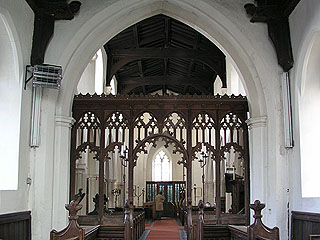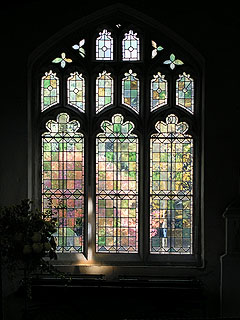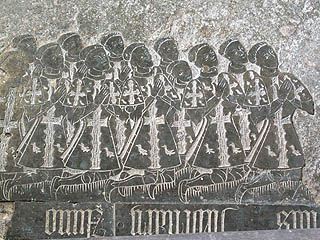This was locked the first time we visited. From the outside, it hardly looks very promising - it is marred by its location (almost on top of the ghastly A14) and the top of the tower is very obviously a Victorian rebuild.
We returned, though, and fetched the key from a very cheerful gentleman who didn't seem the least bit upset that a dishevelled young man was disturbing his Sunday tea. I've got used to keyholders eyeing me suspiciously, and I can hardly blame them, but it's still nice when someone is actually pleased to let you get into their church.
Much of the nave is 14th century, although there is a fragment of a 12th century arch in the wall above the south arcade that speaks of an older building on the site. The clerestory is 16th century, and seems to have obliterated the top half of what must have been a wonderful wallpainting of St Christopher. Parts of his midriff survive, along with a vicious looking demonic mouth snapping at his feet.
Also worth noting in the nave is the font - a solid 15th century octagonal bowl sitting on winged angel heads. You don't see many of them here in Cambridgeshire, though the design is very common over the border in Suffolk.
One feature that puzzled us was this: from many of the arches in the nave, there were little bundles of cloth hanging on strings. Perhaps they were possets, filled with significant herbs? We sniffed them, but they were unscented. I got quite excited, speculating about the ritual significance of Herb of Grace and Balm of Gilead, until Mark noticed that they were actually connected to a mechanism for opening the windows in the clerestory.
The nave is small, but the chancel seems tiny by comparison. It was completely rebuilt in the 1880s restoration and there's not much to see - I will refrain from commenting on the ridiculous angels in the roof. The 15th century screen repays close examination, though. The dado panels are decorated with blind arcades, and the carving in the spandrels is really very intricate - including a couple of tiny green men with shoots bursting from the corners of their mouths.
Just underneath the chancel arch is my favourite thing in the church. There's a brass, almost covered by the pulpit, to Sir John Anstey, lying there in his armour and presumably getting a good view every time the vicar climbs up to read a lesson. His wife, unfortunately, is long gone, but below his feet cluster his children - all 16 of them, his sons all in identical surcoats. I don't normally get excited about brasses, but this one is charming.
St Mary is kept locked, but there are keyholders listed


